[高一英语]Module 5 A Lesson in a Lab
Module 5—A lesson in a lab课文翻译解析
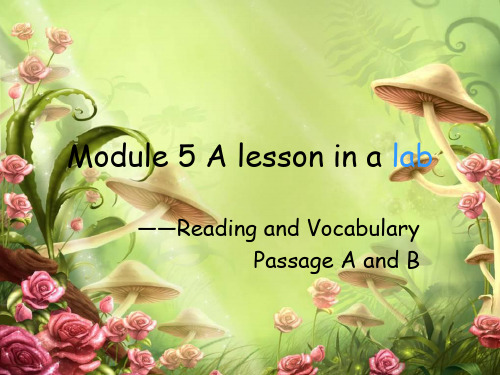
铁在无空气的水中 方法:(1)把试管中加入一半水; (2)将水烧开保持3分钟(这样可以保证 水中无 空气); (3)在水中放2~3枚洁净的铁钉; (4)在水中加些油,这样做可以防止空气进入水 中; (5)把试管放置一周。 结果:铁钉在没有空气的水中未生锈。 结论:铁在没有空气的水中不生锈。 铁在普通的水中 方法:(1)在试管中加入一半水,并在水中放2~3枚洁 净的铁钉; (2)把试管放置一周。 结果:铁钉在含有普通水的试管中生锈。 结论:铁在普通的水中会生锈。
Translation B
一个简单的科学实验 下面是对一个简单科学实验的描述。它向我们表明了铁是 怎样与空气和水反应的。 目的: 弄清铁是否在下列状态下生锈:(a)在干燥的空气中;(b) 在没有空气的水中(没有空气的水);(c)在普通的水中。 仪器: 3颗洁净的铁钉、试管、试管夹、棉花、油、本生灯(即煤气灯 或是喷灯) 铁在干燥的空气中 方法:(1)把若干铁钉置于试管底部; (2)顺着试管塞入一些棉花;(3)把试管放置一周。 结果:一周后,铁钉未生锈。 结论:铁在干燥的空气中不生锈。
• • • • •
• • •
•
Leave sth+地点 把某物落在某地 Leave sth. With sb. 把某事/某物委托给某人 Leave sth. behind 把某事/某物抛在后面 Conclusion n. 结论 Come to a conclusion = reach a conclusion =draw a conclusion 得出结论 in conclusion 最后 boil vt. 煮;煮沸 boiling water 正沸腾的水;boiled water 烧开的水 类似的还有:the rising sun 正升起的太阳 the rised sun 升起的太阳 a developing country 发展中国家 a developed country 发达国家
高中英语外研版必修一《module 5 a lesson in a lab》课件
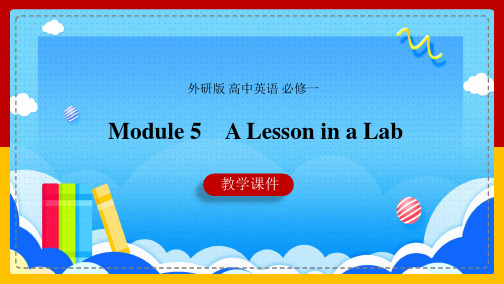
重点单词
点拨 (1)achieve one’s aim实现某人的目标 take aim at向……瞄准 with the aim of意在…… aim to do sth./aim at doing sth. 力求做某事 be aimed at目的是;旨在 (2)aimless adj.无目的的 aimlessly adv.无目标地 【点津】在take aim at中,aim前不能加冠词,即便aim前有形容词,也不可 加冠词。
重点单词
重点短语
重点短语
1. add...to...往……加入……;把……加到…… 教材原句 ① Add (add) some oil to the water. ◆单句填空 ②(202X课标全国Ⅲ) Adding (add) the money to her fund made Georgia agree to sell some of her objects. ③The dictionary is out of date: many words have been added to the language since it was published.
重点单词
④In our daily life, everyone fails every now and then. It is how you react that makes a difference. ◆完成句子 ⑤He didn’t believe it and even reacted strongly against me. 他不相信,乃至强烈反对我。 ⑥ How a person reacts to criticism often means the difference between success and failure.一个人对批评做出怎样的反应通常意味着他是成功 还是失败。
外研版必修一Module 5 A Lesson in a Lab完整优秀教案

完整教案外研版必修一Module 5 A Lesson in a Lab Period 1Teaching aims:1. To introduce some general science.2. To learn some words related to the theme of this module.3. To develop speaking ability by practicing saying the numbers, especially the fractions. Important and difficult points:1. Arouse the students' interests and love in science.2. Enable the students to understand some elements about the chemistry lab.3. Make the students know how to read the numbers.Teaching procedures:Step 1. IntroductionActivity 1The aim of the activity is to ask the students to finish the quiz about general science to arouse their interest in science.The activity can be done as follows:Firstly, ask the students to go through the following the quiz and make their choice on their own. Quiz: How much do you know about general science?1. Water exists __________.(b) as a solid and a liquid only (a) as a solid, a liquid and a gas2. When you heat a metal, it will ___________(b) contract (a) expand3. Steel is mixture of_____________.(b) iron and oxygen (a) iron and other substances.4. _______________ of the earth's surface is water.(b) 50%(a) Two-thirds5. The distance of the sun from the earth is ______________ kilometers.(b) 150,500,500(a) 25,5006.The earth is 4.6______________ years old.(b) billion(a) million7. The earth is ______________ the moon(b) forty-nine times larger than(a) twice as large asThen put the students in pairs to compare their answers and call back the answers from the class. Finally ask them to listen to the tape about the above quiz and check their answers.Answers: 1. a; 2. a; 3. a 4. a; 5. b; 6. b; 7. b.Activities 2 & 3The teacher can prepare some cards about different things for the class at first. Before showing the students the cards,the teacher can say to the whole class: Things can be divided into three kinds, natural, man-made, and either natural orman-made, now I'll show you some cards in my hand, can you tell me which are natural, man-made or both?1 / 12the divide some examples? Then say to the whole the class: Can you give teacher After this, the can continue towhole class into two big groups to compete. The teacher can ask the Ss to speak out as many examples as possible and writeFinally, ask the Ss to open their books at Page 41 and read the words in the box aloud. If possible, they can look up thewords to know what they mean. Of course, the above competition will continue, that is to say, at this moment, the teachercan ask the Ss to put the words in the box on Page 41 in their books in the above table.Step 2. Vocabulary and SpeakingActivity 1The aim of the activity is to have the students know how to read the long numbers. So the activity can be done likethis:Before dealing with the activity, the teacher had better build up a long number byhaving the students say an increasing sequence, eg:three 3thirty-three33three hundred and thirty-three333three thousand, three hundred and thirty-three 3, 333thirty-three thousand, three hundred and thirty-three33, 333At this time, most of the Ss will know the way of reading these long numbers: where to say “million”, “thousand”, and“hundred”. So in order to consolidate what they just learned, the teacher can practice saying thenumbers at the top of Page42 with the students to make sure the Ss have the correct intonation.Then ask the Ss to go through the rest of the numbers in Activity 1 and find the errors individually according to thedirections.Finally the teacher calls back the answers from the class.Answers: 1)The word “thousand”is missing after “four hundred and seventy”; 2)The word “one”(or“a”) is missing before “hundred million”.Activity 2Firstly, the teacher point at the fractions and say them in English. At the same time the teacher have the Ss repeat themafter him or her.Then the teacher and the Ss make an analysis about the rules of reading fractions in English together. Finally the teacher ask the Ss to read the rest of the fractions in Activity 2 on Page 42 in their books in English on theirown. If necessary, the teacher can write down the correct answers on the blackboard to check what they read.Answers: 1. two-fifths; 2. five-eighths; 3. nine-tenths 4.three-eighths;5.five-sixths.Activity 3The teacher should introduce the concept of percentage at first, and then the teacher write down some percentages onthe blackboard and read them out in English.Eg: 35%→thirty-five percent (or: 35 percent); 50 percent equals a half.2 / 12Then have the Ss practice reading aloud the following percentages: 40%; 55%; 85%.Finally have the Ss work in pairs to describe the fractions in Activity 2 as percentages in English. Answers: 1. A quarter is the same as 25%; 2.One third is the same as 33.33r%(thirty-three point three recurringpercent); 3.Four-fifths is the same as 80%; 4. One tenth is the same as 10%; 5. Three-quarters is the same as 75%; 6. Onehalf is the same as 50%; 7. Two-thirds is the same as 66.66r%(sixty-six point six six recurring percent);8. Two-fifths is thesame as 40%; 9. Five-eighths is the same as 62.5%(sixty-two point five percent); 10. Nine-tenths is the same as 90%; 11.Three-eighths is the same as 37.5%(thirty-seven point five percent); 12.Five-sixths is the same as83.33r%(eighty-threepoint three recurring percent).Step 3. Homework1. Preview the reading part.2.Work in pairs to finish Activities 4& 5 on Page 43.Periods 2 & 3Teaching aims and demands:1. To learn about some vocabulary and knowledge related to science and experiments.2. To know about some metals and get to know their main uses in our lives.3. To make the students know how to do a simple experiment and write the report about it in English.4. To deal with all the activities1-6 about passage A and passage B on page 44-45.5. To develop students' expression ability as well as reading ability by practicing these two passages.6. To raise students' interests in science and form the rigorous scientific attitude.Teaching key points:1. To make the students understand and grasp the vocabulary and knowledge related to science and experiments.2. To enable the students to know how to read some passages about simple scientific experiments. Teaching difficulties:To make students learn how to write an experiment report in EnglishTeaching methods:⒈Communicative Approach⒉Task-based Approach⒊Aural-oral Approach with the help of the multi-media computer and the recorderTeaching aids:Multi-media computer; Software; PowerPoint; RecorderTeaching procedures:Step 1:Lead-inAt first show the students the picture of a lab with the help of computer.Then design the following questions and ask the students to discuss them in groups:Are you interested in doing scientific experiments?1.know about2.Suppose you want to do a chemical experiment about some metals, do you think it is necessary tohow they react with other substances?In order to carry out an experiment successfully, what should you prepare for it?3.3 / 12This step is to warm up the students and raise their interests to speak English in class. Because all these questions arey close to the students' daily life and studying ver Pre-readingStep 2.and vocabulary to know some in doing scientific experiments, now let's get you Teacher: Since are interestedknowledge related to science and experiments.as of the computer with metals on the screen the help At the same time I can type out some pictures about somefollows:) 钙calcium() ⑷magnesium(镁⑴potassium(钾) ⑵sodium(钠) ⑶)铜⑻copper( ) ⑺iron(铁) aluminium(⑸铝) ⑹zinc(锌What's this? And what can it be used for?of the above pictures, I can ask the students like this: As I type out eachAt this moment the students' interests are probably approaching a climax. So I further ask them like this: Do youWell, this is what we'll do you know how we can use these metals better? want to know more about these metals? Andstudy very soon.in create a language environment for interests and arouse their students' communication is This step employed toreading passage A and passage B on page 44-45ading Step 3. RePassage AT: Well, let's read through passage A with the tape of it very quickly to try to catch its main idea. Then finish Activity 2on page 44 and give your reasons.Next, ask the Ss to read passage A very carefully to find out the answers in Activity 3 on page 44. Finish this activityby multi-media computer. It can be designed as follows:Which of the metals in the table reacts the most with oxygen and water?1.Potassium, calcium and sodium.What happens when you heat calcium in oxygen?2.It burns to form an oxide.Which metals react with steam? 3.Magnesium, aluminium and zinc.Does iron have a slow or fast reaction with steam?4.It has a slow reaction.Does copper react with water? 5.No, it doesn't.Passage B4 / 12T: Well, from passage A we can see how interesting the experiment about the reaction of metals is! But do you knowAnd what is the correct order to describe a scientific how we can carry out a chemical experiment in a lab successfully?experiment?Ask the Ss to look at Activity 1 on page 44 and give them about 2 minutes to discuss it. Then collect the answers fromthem. At the same time type out the correct answer on the screen with the computer as follows:conclusionresultmethodaimT: Now, let's come to see “A simple scientific experiment”!Then play the tape of passage B for the students and ask them to read the passage with the tape quickly and finishActivity 4 on page 44.In order to lead the students to read the text very carefully, the following task-based questions can be signed to askthem to answer:Can you guess the meaning of the word “apparatus”through the context? Have you known all of the apparatuses of ⑴this experiment?In the second part of the experiment, why must you boil the water? And then why do you add some oil to the water? ⑵For Question 1, some students maybe feel strange to some apparatuses. If so , the following pictures can be typed outwith the help of computer to help Ss to know about:Bunsen burnerTest tube holderTest tube the understood if they have and Ss to make the consolidate what they read in passage B check order Then intask-based a help on the screen with the of computer as be on very experiment well, Activity 5 page 46 can typed out。
必修一module 5A Lesson in a lab知识点讲解及练习

MODULE 5 A Lesson in a labI 重点单词________ 液体________ 膨胀________ 收缩________ 物质________ 混合物________ 煮;煮沸________ 普通的,平常的________ 结论________ 形成________ 溶解;分解;分离________ 天平________ (化学)反应________ 钾________ 钠________ 钙________ 镁________ 铝________ 锌________ 部分的;局部的________ 铜________ 氧化物________ 氧气________ 电________ 蒸汽,水汽________ 漂浮________ 反应________ 有关电的;用电的________ 设备,装备________ 夹子;小镊子________ 火焰________ 设备,工具________ 演讲________ (大学的)科,系________ 吃惊的,惊愕的II 重点词组________ 过去常常做某事________ 在最后二十年________ 以…自豪________ 应该做某事________ 被期望做某事________ 和…不同________ 遗漏,省略,忽略________ 和…一样________ 想起,认为________ 让…按次序排列________ 确保________ 至少________ 向…学习________ 把…加在…上________ 阻止Section I Introduction , vocabulary and speaking语言知识点精讲Steel is a mixture of iron and other substances. 钢是铁和其他物质的混合物l)句中的substance 意为’_______ ”,是________ 名词________________________ ?它是由什么物质组成的?_________________________盐是我们烹任时用的东西。
(原创)高中英语必修1 Module 5 A lesson in a lab. 知识点整理一
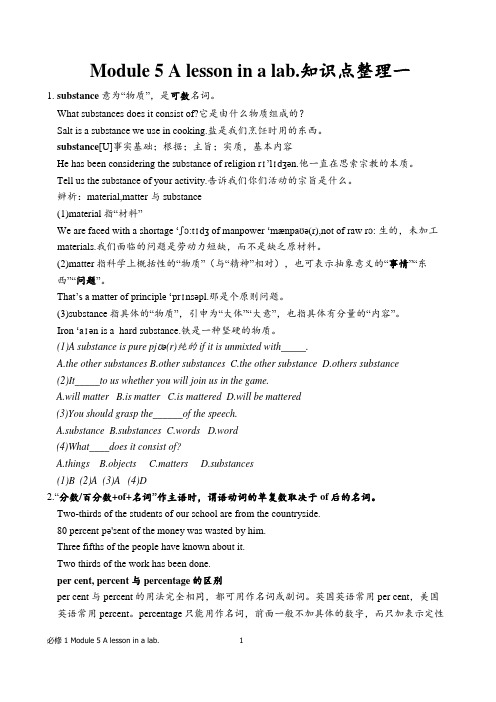
Module 5 A lesson in a lab.知识点整理一1. substance意为“物质”,是可数名词。
What substances does it consist of?它是由什么物质组成的?Salt is a substance we use in cooking.盐是我们烹饪时用的东西。
substance[U]事实基础;根据;主旨;实质,基本内容He has been considering the substance of religion rɪ‟lɪdʒən.他一直在思索宗教的本质。
Tell us the substance of your activity.告诉我们你们活动的宗旨是什么。
辨析:material,matter 与substance(1)material指“材料”We are faced with a shortage…ʃɔ:tɪdʒ of manpower…mænpaʊə(r),not of raw rɔ: 生的,未加工materials.我们面临的问题是劳动力短缺,而不是缺乏原材料。
(2)matter指科学上概括性的“物质”(与“精神”相对),也可表示抽象意义的“事情”“东西”“问题”。
That‟s a matter of principle…prɪnsəpl.那是个原则问题。
(3)substance指具体的“物质”,引申为“大体”“大意”,也指具体有分量的“内容”。
Iron…aɪən is a hard substance.铁是一种坚硬的物质。
(1)A substance is pure pjʊə(r)纯的 if it is unmixted with_____.A.the other substancesB.other substancesC.the other substanceD.others substance(2)It_____to us whether you will join us in the game.A.will matterB.is matterC.is matteredD.will be mattered(3)You should grasp the______of the speech.A.substanceB.substancesC.wordsD.word(4)What____does it consist of?A.thingsB.objectsC.mattersD.substances(1)B (2)A (3)A (4)D2.“分数/百分数+of+名词”作主语时,谓语动词的单复数取决于of后的名词。
必修1-Module5-A-Lesson-in-a-Lab重难知识点总结

Unit 5. A Lesson in a Lab一.重点词汇及拓展1.contract vi.& n.收缩;(订)合约2.float vi.漂浮3.expand vi.膨胀→expansion n.膨胀4.mixture n.混合物→mix v.混合5.electricity n.电→electrical adj.电的,和电有关的→electric adj.发电的,用电的6.reaction n.反应→react vi.反应7.equipment n.设备,装备→equip vt.装置8.astonished adj.吃惊的;惊愕的→astonishing adj.令人吃惊的→astonish vt.惊讶,吃惊→astonishment n.惊讶,惊奇9.aim n.& v.目标;以……为目标→aimless adj.漫无目的的10.balance n.天平;平衡→balanced adj.平衡的二.重点短语1.react with与……反应2.add ...to往……加入3.used to过去常常4.be proud of因……而自豪5.be supposed to理应;应该6.put...in order 使……整齐;使……有条理7.keep ... out of 防止……进入;不让……靠近……三.重点句型1.It is hard to think of a world without metals.很难想象一个没有金属的世界。
2.Here is a table with the metals that react most at the top,and the metals that react least at the bottom.这儿有一个图表,那些反应最强烈的金属在上部,反应最不强烈的在下部。
3.The closer you are,the more you'll see.你靠得越近,你看到的就越多。
高中英语 Module 5 A Lesson in a Lab教案1 外研版必
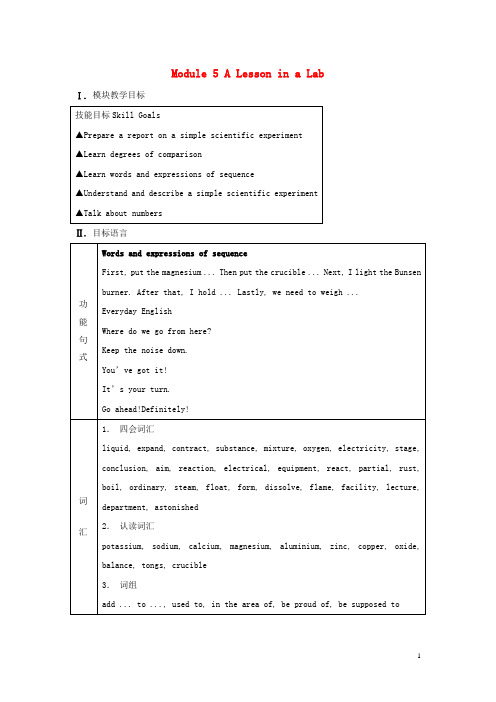
Module 5 A Lesson in a Lab Ⅰ. 模块教学目标Ⅱ. 目标语言Ⅲ.教材分析与教材重组1. 教材分析本模块以“A Lesson in a Lab”为话题,旨在通过模块教学,使学生了解一些基本的科学实验知识,学会怎样写实验报告,并掌握一些相关的词汇与短语,激发学生对科学的兴趣。
此外还要求学生学会读一些大的整数、分数及小数。
从文化的角度来看,鼓励学生了解国外有关科学教学的情况,以扩大学生的知识面,从而激发他们的学习兴趣。
1.1 INTRODUCTION 这部分由三个内容组成。
通过听材料,归纳词语和回答问题这三个形式来完成本部分所涉及到的与科学、实验有关的词语的练习,为以后的各项活动做好准备。
1.2 VOCABULARY AND SPEAKING 这部分设计了一些数字,包括整数、分数和百分数,并通过一些练习让学生熟悉并正确使用英语数字的读法。
1.3 GRAMMAR 1 这部分介绍了形容词比较级中有关倍数的两种主要用法:... times ... than ...和... times as ... as ..., 并通过对比练习来加强学生对这一用法的了解。
1.4 READING AND VOCABULARY 这部分由两篇短文组成。
Passage A 介绍了金属在生活中的重要性,并列举了一些金属在氧气、水及蒸气中的反应及其结果。
Passage B 介绍了A Simple Scientific Experiment,要求学生学习如何描述或写一个科学实验报告。
通过对这两篇文章的学习,学生还可以学会一些科学词汇,有助于今后阅读一些相关的文章。
1.5 VOCABULARY 该部分介绍了带分数的读法,及一些实验仪器的词汇,并配有相关练习。
1.6 LISTENING AND WRITING 这部分听力的内容是实验中的师生对话。
我们可以将此作为对阅读内容在语言技能上的补充。
听力问题的设计本身已经显示了做听力练习的技巧。
高中英语 Module 5 A Lesson in a Lab(典句精讲)教案 外研版必修1

典句精讲1.The science facilities ar e very good with laboratories that have all the latest equipment.这些科研设备非常好,实验室配有最新的设备。
【巧解句构】w ith在此句中意思为“带有……”,其引导的短语对句子作附加说明,that haveall the latest equipment为定语从句,修饰laboratories。
2....and these are always very interesting,as the lectures are peopl e who have made real discoveries in their areas of science.这些讲座总是很有趣的,因为作讲座的人是在各自的科研领域里真正有所发现的人。
【巧解句构】as conj.“因为,由于”,在本句中引导原因状语从句。
as作连词可以引导多种状语从句,主要有时间、原因、方式、比较、让步等从句。
3.Th e Nobel Prize is the highest scient ific prize there is,so we should be very proud of that.诺贝尔奖是目前科学方面的最高奖,因此我们为此感到骄傲。
【巧解句构】there is为定语从句,修饰prize。
4.It is important to know how they r eact with different substances,fo r example,water and oxygen.了解它们如何同像水、氧气这样的物质发生反应的是非常重要的。
【巧解句构】1)it是形式主语,真正的主语是动词不定式to后面的部分。
2)how引导的句子作know的宾语。
【要点剖析】react with同……发生反应。
for example是不完全列举,“例如”。
外研版高一英语必修一 Module 5 A Lesson in a Lab 重点知识点讲解

外研版高一英语必修一Module 5 A Lesson ina Lab 重点知识点讲解1.When you heat a metal,it expands.当你加热金属时,它膨胀。
★考点expand vi. 膨胀A tyre expands when you pump air into it.轮胎一打气就鼓起来。
2.It is hard to think of a world without metals.很难想象一个没有金属的世界。
剖析本句句型为:It’s+形容词+动词不定式短语,句型中it为形式主语,动词不定式短语为真正的主语。
★考点think of想象,设想归纳:think highly of意义高度评价think about意义考虑think over意义仔细考虑3.Different metals have different uses,for example,steel is used in cars,and iron is used in electrical equipment.不同的金属有着不同的用途。
譬如,钢用于车辆,铁用于电子设备。
★考点equipment n. 设备;装备知识归纳:equip sth.with sth.意义用某物来装备某物equip sb.for sth.意义使某人为某事做好准备/使某人有能力做某事4.When we use metals,it is important to know how they react with different substances,for example,water and oxygen.使用金属时,要了解金属和不同的物质(例如水和氧)如何发生反应,这一点很重要。
★考点react vi.(化学)反应react with意义与……起反应react to意义做出反应,回应react against意义反对,反抗5.Aim:To find out if iron rusts (a)in dry air;(b)in water that has no air in it(air-free water);(c)in ordinary water.。
高中英语 Module 5 A Lesson in a Lab(第三课时)教案 外研版必修1
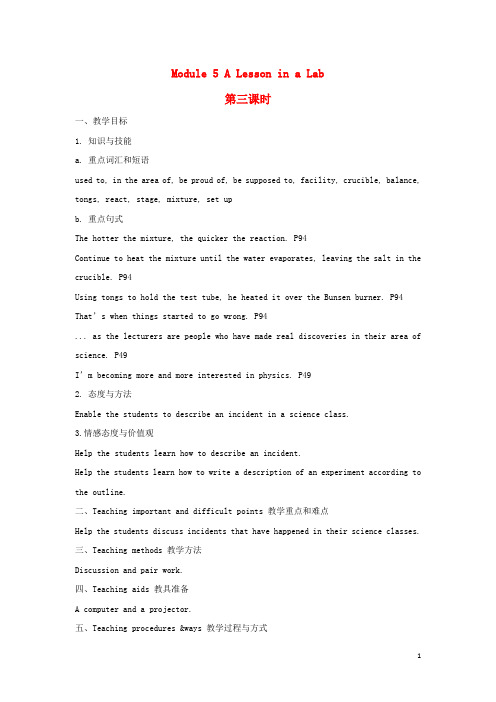
Module 5 A Lesson in a Lab第三课时一、教学目标1. 知识与技能a. 重点词汇和短语used to, in the area of, be proud of, be supposed to, facility, crucible, balance, tongs, react, stage, mixture, set upb. 重点句式The hotter the mixture, the quicker the reaction. P94Continue to heat the mixture until the water evaporates, leaving the salt in the crucible. P94Using tongs to hold the test tube, he heated it over the Bunsen burner. P94 That’s when things started to go wrong. P94... as the lecturers are people who have made real discoveries in their area of science. P49I’m becoming more and more interested in physics. P492. 态度与方法Enable the students to describe an incident in a science class.3.情感态度与价值观Help the students learn how to describe an incident.Help the students learn how to write a description of an experiment according to the outline.二、Teaching important and difficult points 教学重点和难点Help the students discuss incidents that have happened in their science classes.三、Teaching methods 教学方法Discussion and pair work.四、Teaching aids 教具准备A computer and a projector.五、Teaching procedures &ways 教学过程与方式StepⅠ RevisionCheck the students’ homework.For these two exercises, ask the students to read out the complete sentences. T: From Exercise 4, we know that we can use much, a bit, a lot, a little to modify the comparative expressions. Besides these, we have other words to do this. Now please look at the sentences on the screen. Read the sentences and pay attention to the bold face.You have far more imagination than I have.It’s slightly warmer today.She’s actually a good deal older than she looks.Do you feel any better today?She was no older than Zilla.You must go and get some more milk.He is fat, but his brother is still fatter.This book is even more useful than that one.My sister is ten years younger than me.You’re a head taller than Jane.It was one-fourth cheaper than the market price.After the students have finished reading, ask them to make a conclusion of the words to modify the comparative degree.T: By now we’ve learned many words that can modify the comparative degree. What are they?S1: They are much, a lot, far, a bit, a little, slightly, any, no, some, even, still, a head, ten years and so on.T: Yeah, that’s right. Now, that’s all for the home-work. Let’s come to Reading. Step Ⅱ Lead-inT: Do you know this man?S1: He is Ting Zhaozhong, a world-famous Chinese scientist. He once won the Nobel Physics Prize.T: That’s right. He is a top-class scientist. Many outstanding scientists think it is an honor to work with him. What he often says is “I don’t know”. We know science is a serious thing. You can’t be too careful in it. I think this is the real spirit that a scientist and the person who aims to be a scientist should have. Step Ⅲ Reading (P94)Task 1: Fast readingT: Now let’s turn to page 94 to see what happened in the chemistry lab. First, read the three summaries about this passage on page 93. After reading the passage quickly, choose the best one.Give the students some time to read the passage.T: Which one do you think can be the best summary of the passage?S1: No. 1 is the best summary, I think.T: Good.Task 2: Careful readingThe purpose of this task is to answer the eight questions in Exercise 11, and let the students get familiar with some new words in this Module.T: Now, let’s read the questions in Exercise 11, so that you can know what you should do when you are reading. Now read the passage carefully and find the answer to each question. Mark where the answers are and then number them. So that you can find them quickly when you need these answers.Let the students do the job in pairs. One asks the questions and the other answersthem. While the students are asking and answering the questions, walk around the classroom to see if they need any help. And at the same time, collect the answers. Step Ⅳ DiscussionT: Well, you often do some experiments in your science lessons, right? Did any incidents happen? Now I’ll give you some time to discuss the incidents that have happened in your science lessons.After a while.T: Who would like to report an incident that happened before?S1: I’d like to. One morning, we were doing a chemical experiment in the school lab. We fetched some solution(溶液) from the cupboard, including oil of vitriol(浓硫酸), and put them on the table. Wang Hua and Ding Ding were in the front row. Xiao Ming and I were in the second row. Suddenly, Wang Hua turned to say something to me, and turned over the bottle with oil of vitriol by accident. The bottle was not covered! The oil of vitriol splashed. Soon a hole was burned in Xiao Ming’s coat. And his hand was burned to black. He screamed. We were so worried. The teacher ran over to send Xiao Ming to the nearest hospital.Fortunately, nobody else was injured in the incident. However, it taught us a good lesson. Never leave a bottle uncovered on the table.S2: I’d like to tell you about one of the incidents in our chemical experiment. In the experiment, we used Bunsen burner. After the experiment, one of my classmates forgot to cover it. About ten minutes later, a teacher passed the laboratory and smelt the odd smelling. She immediately entered the lab and put out the fire. Fortunately, no further incident was caused. After that all the teachers and students were gathered to have a meeting. The headmaster gave a talk to em-phasize the importance of safety in lab. That’s a good lesson.T: Yeah, if the teacher didn’t notice the incident, it would have been a terrible fire. We often think it’s impossible to make an accident. But as a saying goes, “It’s not too careful to do a thing.” We should always keep the saying in mind. Step Ⅴ Cultural CornerT: In this Module, we’ve learned many things about scientific experiment. Maybesome of you find it interesting, because you are interested in science; while others may find it’s dull, because they prefer art lessons. In our class, who enjoy study-ing science? And why?S1: I like studying science. I like maths best. When I work out a problem, I feel very happy.S2: I like chemistry. It’s very interesting to see that you add one substance to another, and they react and change into a new substance. That is fantastic!T: Knowledge is power. Whatever subjects you enjoy learning, you should devote yourselves to them. Or you won’t make any achievement. Now let’s turn to page 49. Read the passage and answer this question: Why has Mark become more interested in science?Give the students some time to do this in pairs, and then check the answers. T: Are you ready to answer the question?Ss: Yeah!T: Why has Mark become more interested in science?S3: I think there are two reasons. One is that the science facilities are very good in the new school, with laboratories that have all the latest equipment. The other is that they have four chances each term to public science lectures, and the lecturers are people who have made real discoveries in their area of science. I think Mark is a lucky person.T: Yeah. Situations can change a person. In fact, we also have the same chance to learn some knowledge outside class. Channel 10 on CCTV offers a lot of lectures about science and art. Some are given by famous professors. One of my favorite programs is “百家讲坛”. If you often watch it, I believe you’ll benefit from it. Step Ⅵ Summary and HomeworkT: We have learned a lot about scientific experiments. Nowadays, it seems that most people prefer science, because they think science can bring financial benefits, while they do not pay much attention to morality, ethics and love. As a result, there are many disasters and wars in the world. So when we are learning science, we should also pay attention to morality, ethics and love. Today’s homework is to previewPRONUNCIATION and EVERYDAY ENGLISH. OK, time is up. So long, everyone.Ss: So long, teacher.六、板书设计重点词汇:used to, in the area of, be proud of, be supposed to, facility, crucible, balance, tongs, react, stage, mixture, set up重点句式:The hotter the mixture, the quicker the reaction. P94Continue to heat the mixture until the water evaporates, leaving the salt in the crucible.重点语法:used to七、教学反思:这节课的学习,不仅达到了生生互动的效果,也体现了师生互动的优势。
高中英语 Module 5 A Lesson in a Lab 外研社必修1知识精讲

【本讲教育信息】一. 教学内容:Module 5 A Lesson in a Lab二. 重难点讲解1.heat vt.& vi. 加热;变热;使温暖 n. 热,热爱(1)Please heat the room, it’s too cold.(2)The hall will not heat up easily.(3)The sun gives us heat and light.2. expand v. 扩大,增加,增强,扩展;contract. v. 收缩,缩小,缩短;Metals expand when they are heated.Metals contract as they get cooler.3. substance n. 物质(1)What substance does it consist of?(2)This is a chemical substance.4. aim n. 目标 v. 瞄准,对准,力争……Take careful aim at the target before firing.He aimed his gun at the target, fired and missed it.5. react v. 作出反应,回应搭配: react to sb./sth.react against sb./sth.6. put … in order 把……有序排列,整理相关:in order 有序的out of order 无序的by order of …奉……的命令place an order with sb. for sth.in order toin order that7. be supposed to相当于shouldYou’re supposed to pay the bill by Friday.You’re not supposed to play football in the classroom.8.The closer you are, the more you’ll see.the more…. the more 结构是一种非常重要的形容词比较级结构,比如:The sooner we get this finished, the better we’ll be pleased.The harder we study, the more beautiful life we’ll have.9. It’s hard to think of a world without metals.本句中,it 为行事主语,真实主语是不定式to think of a world without metals,这是一个重要的不定式做主语的结构。
外研版 高一英语课本翻译 Module 5 A Lesson in a Lab(带要点)
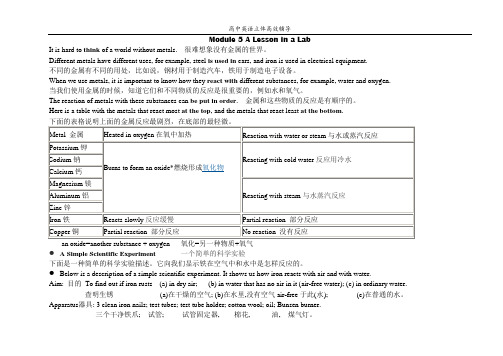
Module 5 A Lesson in a LabIt is hard to think of a world without metals. 很难想象没有金属的世界。
Different metals have different uses, for example, steel is used in cars, and iron is used in electrical equipment.不同的金属有不同的用处,比如说,钢材用于制造汽车,铁用于制造电子设备。
When we use metals, it is important to know how they react with different substances, for example, water and oxygen.当我们使用金属的时候,知道它们和不同物质的反应是很重要的,例如水和氧气。
The reaction of metals with these substances can be put in order. 金属和这些物质的反应是有顺序的。
Here is a table with the metals that react most at the top, and the metals that react least at the bottom.an oxide=another substance + oxygen 氧化=另一种物质+氧气● A Simple Scientific Experiment一个简单的科学实验下面是一种简单的科学实验描述。
它向我们显示铁在空气中和水中是怎样反应的。
●Below is a description of a simple scientific experiment. It shows us how iron reacts with air and with water.Aim: 目的To find out if iron rusts (a) in dry air; (b) in water that has no air in it (air-free water); (c) in ordinary water.查明生锈(a)在干燥的空气; (b)在水里,没有空气air-free于此(水); (c)在普通的水。
高中英语Module 5 A Lesson in a Lab 优秀课件1

⑨reaction/r
k n/n.反响
⑩put sthin order 把某物按顺序排列
[3]that react most是that引导的定语从句,修饰the metals。
⑪at the top (of)在(……)顶端
⑫form/f m/vi.&vt.形成
⑬oxide/ ksa d/n.氧化物
A group of R.O.Korean researchers have found a way to turn cigarette butts into the materials required for batteries.Kim Gil-Pyo from the Seoul National University says he saw people throwing away cigarette butts and that got him thinking.He began wondering if something useful could be made from them.
steam
Iron Copper
Reacts slowly Partial⑭ reaction
Partial reaction No reaction
*an oxide=another substance+oxygen
A Simple Scientific Experiment Below is a description of a simple scientific experiment.[4]It shows us how iron reacts with air and with water.[5] Aim⑯: To find out if iron rusts⑰[6](a) in dry air;(b) in water that has no air in it[7] (air-free⑱water);(c) in ordinary⑲ water. Apparatus:3 clean iron nails;test tubes;test tube holder;cotton wool;oil;Bunsen burner.
高中英语Module 5 A Lesson in a Lab 教案

Module 5 A Lesson in a LabThe First Period ReadingTeaching goals教学目标1. a. 重点词汇expand, contract, conclusion, method, liquid, solid, iron, mixture, oxygen, electricity, aim, equipment, react, result, steam, substance, boil, float, form, dissolve, rustb. 重点句式It is hard to think of a world without metals.It is important to know how they react with different substances, for example, water and oxygen.This makes sure there is no air in the water.2. Enable the students to describe a scientific experiment.Enable the students to learn some words concerning scientific experiment.3. Help the students learn about the steps of a simple scientific experiment so that they can describe a similar one.Teaching important points教学重点Help the students learn how to describe a simple scientific experiment.Teaching difficult points教学难点Help the students understand the two tables of Passage A and Passage B.Teaching procedures & ways教学过程与方式Step ⅠWarming-upThe purpose of this part is to let the students know and get familiar with the new words in INTRODUCTION: expand, contract, mixture, substance, oxygen and electricity. First, write down the words on the black-board, and then teach them the meaning of each word by questioning.T: Hello, everyone! Do you know the program Lucky 52 on CCTV?Ss: Yeah!T: OK, now suppose I’m Li Yong, and you are competitors. Here are six words on the blackboard. What you should do is to guess the meanings of them. If you can’texpress them in English, you may say in Chinese. The quicker, the better. Are you clear?Ss: Yes.T: Listen. What do we take in when we breathe?S1: Air.T: Right. But not exact.S2: 氧气。
- 1、下载文档前请自行甄别文档内容的完整性,平台不提供额外的编辑、内容补充、找答案等附加服务。
- 2、"仅部分预览"的文档,不可在线预览部分如存在完整性等问题,可反馈申请退款(可完整预览的文档不适用该条件!)。
- 3、如文档侵犯您的权益,请联系客服反馈,我们会尽快为您处理(人工客服工作时间:9:00-18:30)。
Which are natural? Which are man-made ? Which are both ?
electricity iron air some metal
steel glass some metal
Electricity and some metals (alloys for example) can be man-made and occur naturally
1/4
a quarter
分数的读法
3/4
three quarters
4/5
four-fifths
fifty-one million
one-tenth a quarter(one-fourth) one point four three hundred and six point seven
分数的读法
分子读基数词,分母读序数词;分子大于1序数词要用复数:
1/4
2 -
3 5
one-fourth
two and three-fifths
5. (a) The distance of the sun from the earth is 25 ,500 kms.
(b) The distance of the sun from the earth is
150,500,500 kms.
6. (a) The earth is 4.6 million years old.
1. (a)
Water exists as a solid, a liquid and a gas.
(b)
2. (a)
Water exists as a solid and a liquid only.
When you heat a metal, it expands.
(b)
When you heat a metal, it contracts.
3. (a) (b)
Steel is a mixture of iron and other substances. Steel is a mixture of iron and oxygen.
4.
(a) Two-thirds of the earth’s surface is water. (b) 50% of the earth’s surface is water.
71﹪
29﹪ 9,600,000 1,951,000,000
1/10
1/4 1.4
306.7
→ → → → → → → →
seventy-one percent twenty-nine percent nine million, six hundred thousand one billion, nine hundred and
(b) The earth is 4.6 billion years old.
7. (a) The earth is twice as large as the moon. (b) The earth is forty-nine times larger than the moon.
Put these words in pairs or groups.
biology
Newton Madam Curie
exist solid liquid metal expand contract mixture substance oxygen surface
Read through the questions quickly and find out the answers to them. 1.How does water exist? 2.If you heat a metal,what change will happen? 3.What is steel made from? 4.What is the earth's surface mainly covered by? 5.How far is the sun from the earth? 6.How old is the earth? 7.Which is larger,the earth or the moon?
2/3
two-thirds
另外还有下面一些表示法:
1/2 3/4
1 - 12
a /one half three quarters one and a half
1/4 2-
1 4
a /one quarter two and a quarter
分数的读法
1/2
a half
1/3
a third
2/3
two-thirds
Module5 A Lesson in a Lab
2012-8-12
Albert Einstein
Thomas Elfred Nobel
physics
Darwin Li Zhengdao
chemistry
Thomas Edison Albert Einstein
Suggested answers
1.electricity,iron,some
air 2.steel,some metals and glass 3.electricity and some metals
metals and
Reading
2
21 201 2,001 20,001
200,001
air contract earth gas liquid oxygen moon solid sun expand
air---gas---oxygen earth---sun---moon contract---expand gas---liquid---solid
electricity iron metal steel air glass
2,000,001
→ → → → → → →
two twenty-one two hundred and one
two thousand and one
twenty thousand and one two hundred thousand and one two million and one
Reading
